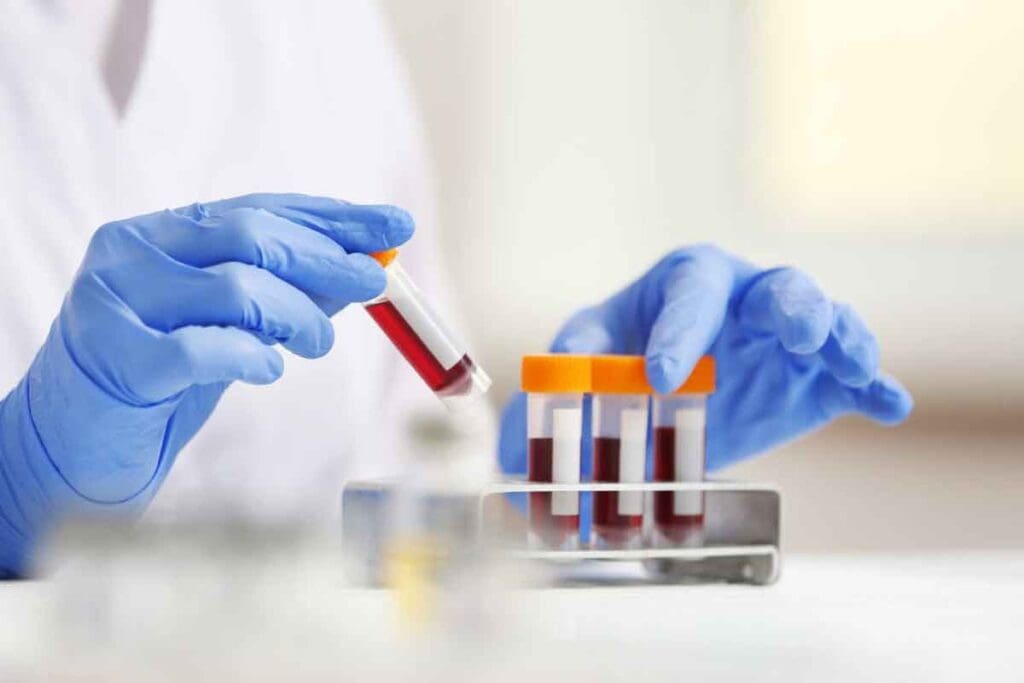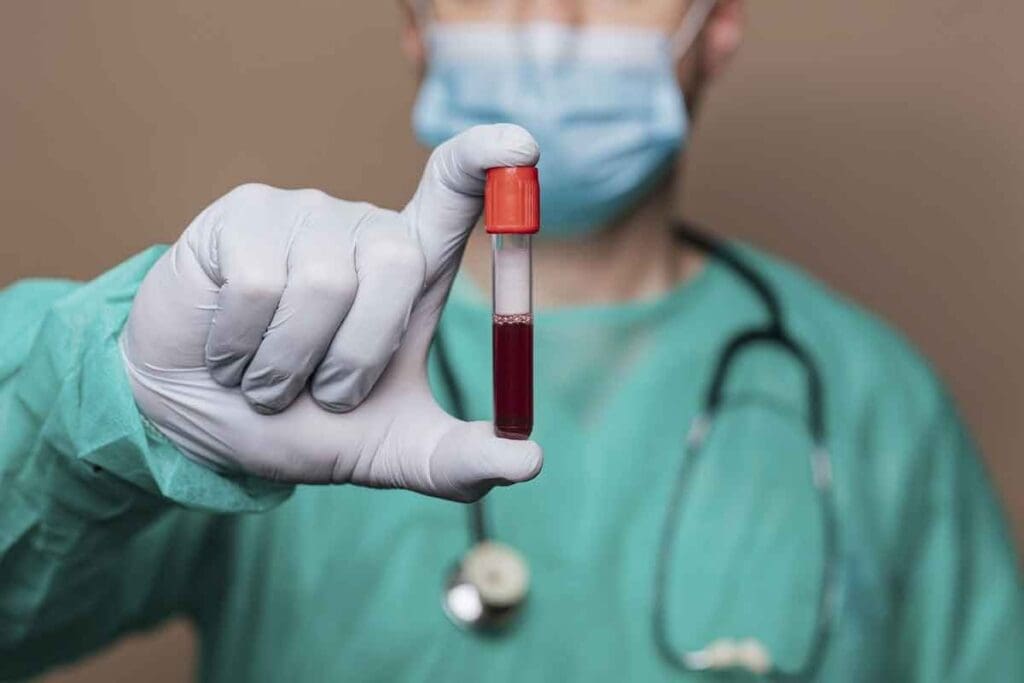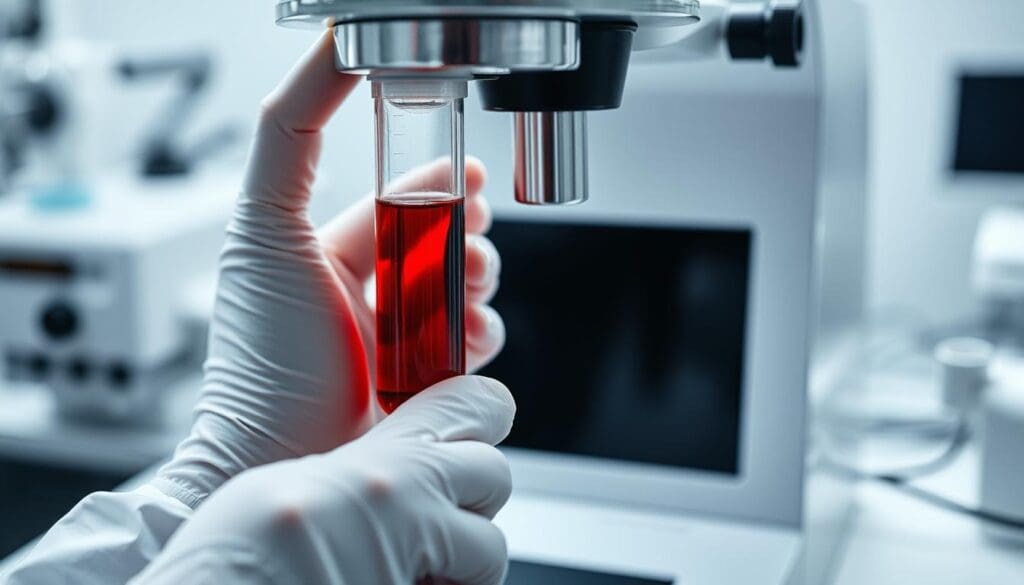Last Updated on November 14, 2025 by Ugurkan Demir

Knowing your hemoglobin concentration is key to checking your health. It shows if your blood is carrying enough oxygen.
At Liv Hospital, we stress the need for good hemoglobin levels. For adults, the normal range is 13.5–18 g/dL for men and 12–16 g/dL for women. These levels help your body’s parts get the oxygen they need.
We’ll dive into the main points about hemoglobin concentration. We’ll cover normal ranges, its link to hematocrit, and what affects it.

Hemoglobin is a protein at the heart of our circulatory system. It helps deliver oxygen from the lungs to our body’s tissues. This makes it a key part of our health.
Hemoglobin is a crucial protein in red blood cells for oxygen transport. It has four iron atoms, allowing it to carry four oxygen molecules. This makes it very good at getting oxygen to our tissues.
The amount of hemoglobin in our blood varies. Normal levels are different for men and women. For example, women generally have lower hemoglobin levels than men.
Red blood cells have a lot of hemoglobin. It’s estimated that one red blood cell has about 270 million hemoglobin molecules. This high amount lets red blood cells carry a lot of oxygen.
Knowing how many hemoglobin molecules are in red blood cells shows how oxygen transport works. Keeping our hemoglobin levels right is key for oxygen delivery. It helps avoid problems like anemia or too much blood.
Understanding normal hemoglobin levels is important. It helps us see why this protein is vital for our health.
Hemoglobin concentration is a key health indicator. It’s measured in grams per deciliter (g/dL). This unit shows how much hemoglobin is in your blood.
Hemoglobin concentration is usually measured with automated analyzers. They give results in g/dL. “HGB” is another term for this measurement. We use it to spot and track conditions like anemia or polycythemia.
Key aspects of hemoglobin measurement include:
For adult males, a normal hemoglobin level is between 13.5 and 18 g/dL. Females usually have a range of 12 to 16 g/dL. These numbers can change slightly based on the lab and testing methods.
Hemoglobin and hematocrit are related measures. They tell us about red blood cell count and oxygen delivery. Hematocrit shows the volume of red blood cells in the blood, as a percentage.
In adult males, hematocrit values are between 40% and 54%. This shows the red blood cell proportion in the blood. Knowing how hemoglobin and hematocrit relate is important. Both are linked to red blood cell count and oxygen delivery.

The relationship between hemoglobin and hematocrit is as follows:
Knowing what normal hemoglobin levels are is key for diagnosing and treating health issues. Hemoglobin levels change a lot depending on age and sex. We’ll look at these changes to understand what’s considered normal.
Adult males and females have different normal hemoglobin levels because of their body differences. Adult males usually have levels between 13.5 and 18 g/dL. Adult females usually have levels between 12 and 16 g/dL. These ranges come from studies of healthy people, as the NCBI Bookshelf explains.
“The normal Hb level for males is 14 to 18 g/dl; that for females is 12 to 16 g/dl,” medical texts say. This shows how hemoglobin levels differ by gender. Doctors use these values to check if a patient’s hemoglobin is normal.
Hemoglobin levels change with age too. Kids and teens have different normal ranges than adults. As we get older, our hemoglobin levels can change for many reasons.
It’s important to think about these age changes when looking at hemoglobin test results. For example, older adults might have slightly different normal ranges because of body changes with age.
Our bodies change as we age, affecting how we make hemoglobin and red blood cells. Knowing these changes helps doctors diagnose and treat hemoglobin-related problems more accurately.
Healthcare providers can better diagnose and manage hemoglobin-related conditions by understanding these demographic differences. It’s important for people to talk to their doctors about their hemoglobin levels and what they mean for their health.
It’s important to know what affects hemoglobin levels for accurate diagnosis and treatment. Many factors can change hemoglobin levels. So, it’s key to consider these when looking at test results.
Physiological factors greatly impact hemoglobin levels. For example, age, sex, and hydration status can all play a part. Dehydration can make hemoglobin levels seem higher because of less plasma.
Also, some medical conditions can change how much hemoglobin is made or broken down.
Where you live and the environment also affect hemoglobin levels. Living at high altitudes is known to increase hemoglobin production. This is because there’s less oxygen in the air.
According to an expert clinic, people living at higher elevations might have higher hemoglobin levels. This is a way their bodies adapt to the lower oxygen levels.
These factors show how complex it is to understand hemoglobin levels. A full understanding of an individual’s hemoglobin concentration is needed.
Hemoglobin is key to carrying oxygen in the blood. Knowing the right levels is vital for health and sports performance. It helps keep red blood cells healthy and ensures tissues get enough oxygen.
A good hemoglobin level falls within the normal range, which changes with age and gender. For men, it’s usually between 13.5 to 18 g/dL. Women’s levels range from 12 to 16 g/dL. These ranges show healthy red blood cell function.
Several factors affect what’s considered a ‘good’ hemoglobin level:
Levels outside the normal range might signal health problems like anemia or polycythemia.
Understanding specific hemoglobin values requires knowing the context and individual factors. For example, a hemoglobin of 12 g/dL is normal for women but might be low for men. A level of 16 g/dL is normal for both and is often seen as optimal for oxygen delivery.
It’s vital to talk to a healthcare professional to grasp what a specific hemoglobin level means for your health.
Research shows that levels below 10.0 g/dL may point to anemia. This shows how important it is to keep hemoglobin levels optimal for health.
Understanding your hemoglobin test results is key to spotting health issues early. Hemoglobin helps carry oxygen to your body’s tissues and organs. Knowing your results can help you catch problems before they get worse.
When you get your hemoglobin test results, it’s important to know what’s normal. An expert clinic says a low hemoglobin level means you might have anemia. Anemia can make you feel tired, weak, and short of breath.
Abnormal hemoglobin rates should raise a red flag. If your hemoglobin is too low, it could mean you have anemia or another problem. High levels might point to dehydration, lung disease, or other issues. Always talk to a doctor to figure out why your hemoglobin is off.
Signs that you should be concerned about abnormal hemoglobin rates include:
If your hemoglobin test shows something’s off, your doctor will want to do more tests. This might include a CBC or an iron test. Depending on what they find, you might need to change your diet, take supplements, or start medication.
It’s vital to work with your doctor to understand your results and find a solution.
In some cases, you’ll need to keep an eye on your hemoglobin levels. By following your doctor’s advice, you can keep your hemoglobin healthy and stay well.
A healthy hemoglobin level is key to avoiding anemia and staying well. We can keep our hemoglobin healthy by eating a balanced diet. This diet should be rich in iron and other important nutrients.
Eating foods high in iron is a great way to support healthy hemoglobin. Beef, dark green leafy veggies like spinach and kale, dried fruits, and nuts are all good sources. Adding these to our meals can help prevent anemia caused by iron or vitamin deficiencies.
Changing our lifestyle can also help keep hemoglobin levels healthy. For example, drinking less alcohol and not smoking can greatly improve our health. This includes keeping our hemoglobin levels in check.
Regular health check-ups are also very important. They let doctors watch our hemoglobin levels and catch any problems early. This way, we can take steps to prevent or treat issues quickly.
Knowing what affects hemoglobin levels is also helpful. This includes both our body’s natural processes and external factors. Being informed helps us make better choices about our diet and lifestyle.
In short, keeping hemoglobin levels healthy needs a few steps. We need a balanced diet, a healthy lifestyle, and regular health checks. By doing these things, we can avoid anemia and keep our hemoglobin levels where they should be for our health and happiness.
Knowing about hemoglobin concentration is key to keeping our blood healthy. Hemoglobin is a protein in red blood cells that carries oxygen. We’ve looked at why it’s important, its normal ranges, and what affects it.
Keeping hemoglobin levels healthy is vital to avoid anemia and ensure tissues get enough oxygen. By understanding hemoglobin, we can take steps to keep our levels right. This helps us make better health choices and know when to see a doctor.
In short, hemoglobin concentration is vital for our health. By knowing its importance and how to keep it healthy, we can boost our health and life quality.
Hemoglobin levels change with age and sex. Adult males usually have 13.5-18 g/dL. Adult females have 12-16 g/dL.
Average hemoglobin levels differ by age and sex. Adult males have about 15.5 g/dL. Adult females have around 14 g/dL.
Hemoglobin is measured in grams per deciliter (g/dL). Tests like complete blood count (CBC) are used.
Hemoglobin and hematocrit show red blood cell levels. Hematocrit is the red blood cell proportion. Hemoglobin is the amount of hemoglobin protein.
Many things can change hemoglobin levels. These include age, sex, altitude, and nutrition.
A good hemoglobin level is within the normal range for your age and sex. For adults, it’s 13.5-18 g/dL for males and 12-16 g/dL for females.
Eat a balanced diet with iron, vitamin B12, and folate. Avoid things that harm hemoglobin production.
A level of 12 g/dL is low for males but normal for females. A level of 16 g/dL is normal for both, showing good oxygen delivery.
Be worried if hemoglobin is way off the normal range. This could mean anemia or dehydration.
Talk to a doctor after abnormal results. They’ll find the cause and help fix any health issues.
Each red blood cell has about 270 million hemoglobin molecules. These carry oxygen throughout the body.
The best hemoglobin level varies by individual. Generally, staying within the normal range is key to health and performance.
Subscribe to our e-newsletter to stay informed about the latest innovations in the world of health and exclusive offers!